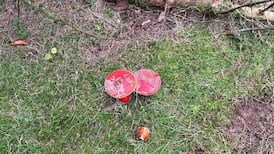When my children were young, one of their and my favourite books was Roald Dahl’s novel Fantastic Mr Fox. The hero of the story, Mr Fox, is trapped underground for several days by three vengeful farmers, so he devises a plot to acquire provisions for his family. He tunnels into the farmers’ chicken houses and cider cellar and shares the spoils with his underground neighbours, the badgers, rabbits, moles and weasels.
I always thought that it was fanciful for a fox to share its quarters with a range of other mammals until I started to use a trail camera outside a badger sett on my own farm. This handy device is triggered by movement and will capture images of any animal in front of the lens. Imagine my surprise when I started to record not only a badger family but numerous visits by fox, pine marten, rabbit, rat and even domestic cats, entering and leaving the sett entrances. It appears that this extensive network of tunnels in the wood is home to whole community of mammals.
This phenomenon, it seems, is not atypical of large badger setts. A recent paper by Dr Paddy Sleeman and Allen Whitaker of University College Cork used a series of camera traps at 27 badger setts in Co Cork during the Government-sponsored programme of vaccination for bovine TB. As well as the resident badgers, foxes were the most frequently detected wild mammals using the setts, followed by rabbits, domestic dogs and cats. Cattle were recorded twice at the setts. There were also rats, squirrels, minks, hares, fallow deer, stoats and other small mammals (Irish Naturalists’ Journal 2023). Dr Sleeman believes the foxes may seek out badgers for protection.
Old badger setts are extensive networks of tunnels that are dug by generations of these large mammals, usually under the cover of trees. Badgers spend up to 70 per cent of their time underground and they have evolved short muscular limbs, long claws, small eyes and ears for this subterranean lifestyle. The sett is used for sleeping during the day, with the badgers only emerging after dark and returning before dawn. This is where the cubs are born and nursed for their first weeks of life. It forms a safe refuge essential for their survival in the face of numerous threats as well as a warm place to rest in the cold, wet winter months.
READ MORE
Old and well-established badger setts are usually marked by large heaps of spoil outside the entrances as if a mechanical digger has been at work. In preparation for the birth of cubs in the spring, the adults will often drag bundles of dried grass and bracken back along well-used paths and down the sett to use as bedding, leaving characteristic trails of dead vegetation. Some setts are clearly ancient structures that have been used over and over through the centuries. Prof Timothy Roper estimated that one enormous sett in England had 178 entrances, about 50 chambers and 879m of tunnel. He calculated that up to 62 tonnes of soil had been excavated to create this extensive network below ground.
[ Badger admiring picture of badger wins wildlife British photography voteOpens in new window ]
When an old or sick badger dies in the sett, its relatives may block up the chamber to prevent the spread of disease in an act reminiscent of a human funeral. Years later the old skeleton may be removed when later generations of badgers reopen the tunnel. I once found a perfectly clean badger skull lying on the spoil outside a sett entrance.
Badgers have been targeted as potential vectors of TB to cattle with an extensive programme of culling undertaken by government officials over many decades. Official records show the Department of Agriculture killed 7,319 badgers in 2024. However, postmortem tests of culled badgers in Ireland over the last five years have revealed that more than 80 per cent were not infected with bovine TB. The findings have led to increased pressure on the Government to end the slaughter.
I refused to allow the badgers to be disturbed on my own land. Research has shown that extracting or gassing some of the animals can cause the remainder of the surviving animals to disperse and carry any possible disease to surrounding farms. Badgers live complex family lives and, far from being aggressive, they welcome lodgers to share their ample homes. Nobody goes homeless in the woodland.
Richard Nairn is an ecologist and writer. His latest book is Future Wild: Nature Restoration in Ireland












